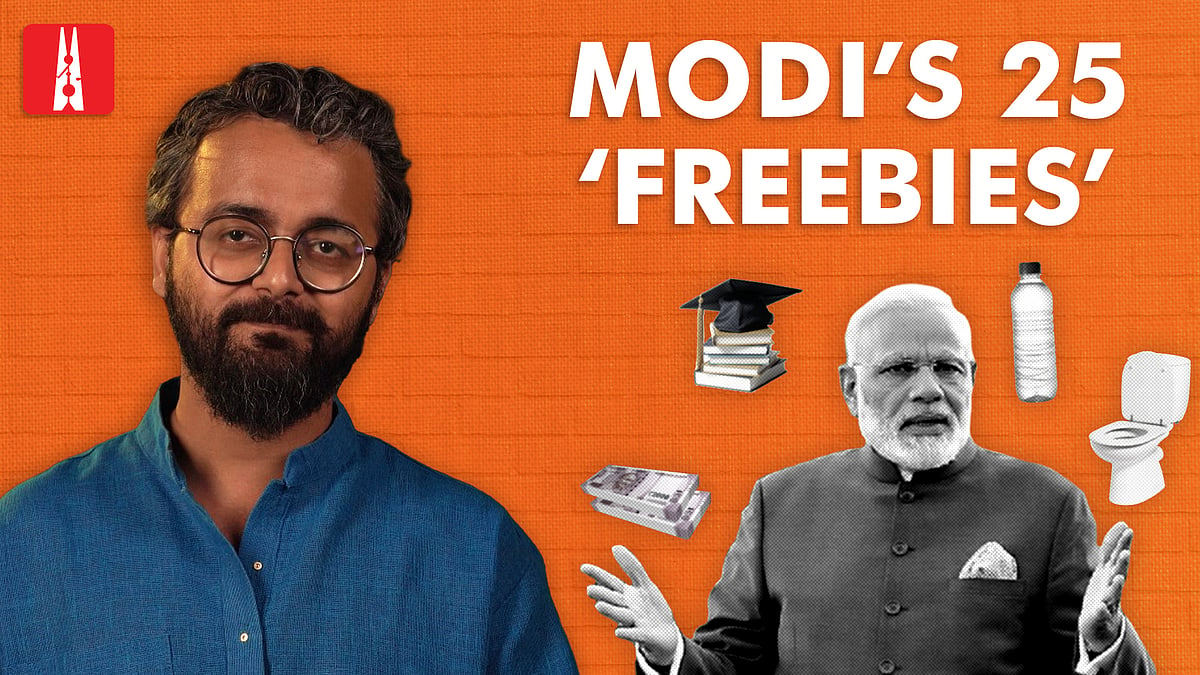The Ultimate Freebie Explainer: Everything you always wanted to know, but were too afraid to ask
Many economists and politicians have weighed in on the issue. We look at it in detail.
Social media needs a continuous inflow of complex societal issues to remain relevant and keep the pot boiling. Over the last few weeks, the “freebies” debate has become another such issue.
In mid-July, at the inauguration of the Bundelkhand expressway in Uttar Pradesh, prime minister Narendra Modi had talked about the promotion of revdi culture, or the distribution of freebies, to buy votes. The Supreme Court is considering a public interest litigation (PIL) filed by Ashwini Kumar Upadhyay who is seeking direction to regulate freebies. Upadhyay is a member of the Bharatiya Janata Party.
The central government has come out in support of the PIL. In early August, solicitor-general Tushar Mehta had said, “The freebies distribution inevitably leads to future economic disaster and the voters also cannot exercise their right to choose as an informed, wise decision.”
During the course of this month, many economists, politicians and experts have weighed in on this issue. This is an attempt to look at the whole issue in detail. What is a freebie? Can the term really be defined? As is being suggested by many, do only state governments offer freebies? What are the different kinds of freebies? Are all freebies visible?
In this piece, I will try offering answers to these, and a few other, questions.
What is a freebie?
At its most basic level, a freebie is a good or service offered by a government free to the citizens or below the cost of producing it.
Take the case of the public distribution system (PDS) run by the central government. This system sells wheat and rice at extremely low prices in order to fulfil the needs of food security. Or take the case of the Mahatma Gandhi National Rural Employment Guarantee Scheme, or MGNREGS, which guarantees 100 days of work to every rural household.
An out and out free market economist may look at these schemes as freebies being offered by a government to buy votes. Nonetheless, both the PDS and MGNREGS have proved hugely beneficial to a large section of the country during the spread of Covid. They have continued to prove beneficial even as the number of Covid cases has come down.
Take the case of the midday meal scheme, in which government primary schools provide children with a cooked lunch. It was launched at a national level in 1995 but was first launched in India by chief minister K Kamaraj in Tamil Nadu’s schools in 1956. The state’s budget for 1956-57 had a provision for free midday meals to children studying in primary schools and belonging to poor families for 200 days a year.
In 1982, MG Ramachandran, then chief minister of Tamil Nadu, upgraded the scheme. He did so by extending the coverage of the scheme to all children between the ages of two and five studying in anganwadis, and also those aged between five and nine studying in primary schools located in rural areas of Tamil Nadu.
In doing so, he faced a lot of criticism from several quarters. Nonetheless, the scheme ended up improving attendance in schools. It also reduced absenteeism. Ultimately, the scheme’s success led to a national-level launch.
Or take the case of the Mukhyamantri Cycle Yojana in Bihar, which was launched in 2006. Under this scheme, the state government helped young girls buy bicycles. A cynic would argue that these girls would grow up and then vote for the political party that initiated the programme. Nonetheless, it led to an increase in the enrolment of girls in secondary schools by 32 percent.
Clearly most economists and politicians wouldn’t consider these schemes as out and out freebies used to buy votes.
Merit freebie or non-merit freebie
Given this, economists talk about merit freebies and non-merit freebies. A good example of a merit freebie is subsidised or free education. While this costs the government every year, it also leads to a more educated workforce in the years to come. Also, the chances of the workforce being more skilled go up.
It also benefits people in other ways. As Hans Rosling, Ola Rosling and Anna Rosling Rönnlund write in Factfulness: Ten Reasons We’re Wrong About The World – And Why Things Are Better Than You Think: “The data shows that half the increase in child survival in the world happens because the mothers can read and write.”
Hence, the spread of literacy leads to families having fewer children. This, in turn, leads to people saving more and the financial savings of a country go up. As Charlie Robertson writes in The Time-Travelling Economist: Why Education, Electricity and Fertility Rate are Key to Escaping Poverty: “When families have lots of children, the children become the parents’ ‘savings’. By the time they become teenagers [they] are hopefully earning an income...Eventually, they become your pension and can provide housing when you’re old."
The point here is that when families have many children, they don’t need savings. Also, if there are five or six children in a family, there is a high chance that the family won’t “have any money left over to save" even if they wanted to.
But as education levels increase, people have fewer children and their savings increase. These savings then help the economy as a whole. As Robertson writes: “The benefits of these savings accrue to the whole country via deposits that are placed in an expanding banking system which then lower the cost of money. The volume of savings rises, so more factories can be built to create jobs and the cost of borrowing of those savings falls, so more of those factories will be profitable and can expand quickly.”


